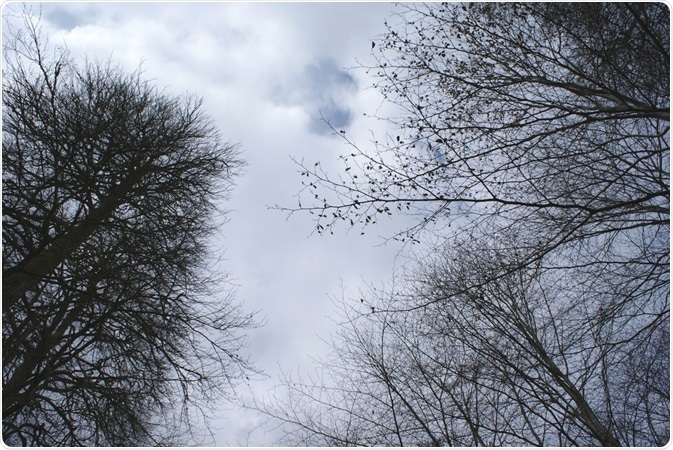Seasonal Affective Disorder (SAD) Causes, Symptoms and Diagnosis
Seasonal affective disorder (SAD) is a psychological condition characterized by depressive symptoms that occur during certain months of the year. Research has highlighted several potential causes of SAD, all of which tend to stem from a biological condition.
 Susilyn | Shutterstock
Susilyn | Shutterstock
What is SAD?
Seasonal affective disorder is a type of recurring major depressive disorder which is characterized as having a seasonal pattern specifier. People with SAD experience depressive symptoms in the fall/winter months, which typically improve with the coming of spring/summer. In order to be diagnosed with SAD, seasonality has to be present, defined as seasonal variations in feeding behavior, social interactions, and energy levels.
Causes of SAD
Research has highlighted several causes for SAD, many of which have biological underpinnings, including neurotransmitters and specific hormones. In addition to this, it is suggested that those who live farther away from the equator are more likely to develop the disorder. For example, within the USA, 1% of the population of Florida is thought to have the condition compared to 9% of those who live in Alaska.
The role of serotonin in SAD
Research investigating serotonin levels in those with and without SAD found that those with SAD had 5% higher levels of SERT (a protein which aids the transportation of serotonin) in the winter months compared to the summer months. SERT transports serotonin from the synaptic cleft to the presynaptic neuron.
Higher levels of SERT consequently result in lower serotonin activity, which has been linked to depressive symptoms. Typically, during the summer, due to increased sunlight, SERT levels are quite low. However, during fall and winter, as the days grow shorter due to lack of sunlight, serotonin activity also decreases.
The role of melatonin and SAD
Melatonin is a hormone that responds to darkness and is linked to producing feelings of sleepiness. Research has suggested that individuals with SAD may overproduce melatonin. During fall/winter months, as the hours of daylight wane, melatonin production increases.
As a consequence, people with SAD often feel sleepy and lethargic. While this may play a role in the onset of SAD symptoms, researchers believe that melatonin production isn’t singly accountable for the development of SAD as a whole.
Due to the reduction in serotonin production and the increase in melatonin levels, there may be a knock-on effect on the circadianCircadian rhythms, which set the body’s clock. Each individual’s circadianCircadian rhythm is synchronized to respond to the changes in external light intensity that occur each day as well as seasonally.
Research has found that in patients with SAD, the body's circadian rhythm misinterprets the change in day length associated with a change in season, compared to those without the condition. This may make it difficult for those with SAD to adjust to seasonal changes.
Vitamin D
Vitamin D is often referred to as the “sunshine” vitamin and is produced in the skin upon exposure to sunlight. During the fall and winter months, due to reduced exposure of the skin to sunlight, people with SAD produce less vitamin D.
Vitamin D is also thought to play a role in combating cancer, autoimmune disease, type 2 diabetes, and depressive disorders, including SAD, as well as influencing serotonin activity.
Other causes of SAD
Other risk factors for SAD include the female sex, younger age, and a family history of depression, bipolar disorder or SAD.
Symptoms of SAD
Similar to people with major depressive disorder, those with SAD may experience the following symptoms:
- Sustained low mood
- Lack of energy or a feeling of lethargy
- Irritability
- Sleeping more than usual
- Weight gain due to overeating
- Withdrawal from social situations
- Lack of enjoyment in activities usually found pleasurable
There are some individuals with SAD who experience depressive episodes in the spring/summer months which remit in the fall/winter months. Their symptoms may vary slightly, but usually include the following.
- Lack of appetite and weight loss
- Sleep problems or insomnia
- Anxiety
- Restlessness
- Episodes of violent behavior
It is important to highlight that cases of SAD can vary in severity. On one hand, there is a milder form referred to as subsyndromal SAD (S-SAD), more commonly known as the “winter blues”. On the other hand, some individuals may be severely affected, which impacts their ability to function on a daily basis.
Diagnosis of SAD
In order to be officially diagnosed with SAD, individuals need to have experienced the above symptoms during two major depressive episodes over a two-year period to demonstrate a temporal seasonal relationship. Full remission, or change to mania or hypomania, must also occur during a particular time of year.
The psychological disorder may also be co-morbid with a range of other conditions such as eating disorders, alcoholism and other depressive disorders. This can make the condition difficult to diagnose.
In order to diagnose SAD, medical professionals might use the Seasonal Pattern Assessment Questionnaire (SPAQ). This retrospective, self-administered diagnostic tool was first developed by Rosenthal and colleagues. There are specific questions within the tool which also produce a number on the Global Seasonality Score (GSS). A combination of GSS and SPAQ can be used by clinicians to assess patients fully.
Sources
- Seasonal Affective Disorder: An Overview of Assessment and Treatment Approaches.
- Vitamin D: The “sunshine” vitamin.
- Seasonal Affective Disorder: An Overview and Update
- Seasonal Affective Disorder
Further Reading
- All Seasonal Affective Disorder (SAD) Content
- What is Seasonal Affective Disorder?
- Seasonal Affective Disorder Treatment
- Natural Remedies for Seasonal Affective Disorder (SAD)
- Genetics of Seasonal Affective Disorder
Last Updated: Mar 26, 2019

Written by
Chloe Barnett
Chloe has a B.Sc. in Medical Sciences from the University of Leeds and during her time there she enjoyed being close to the Yorkshire dales. Chloe loves the outdoors, spending her spare time hiking and exploring the UK countryside as well as listening to live music and running.
Source: Read Full Article


